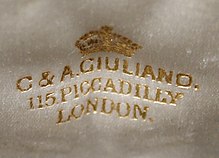| The topic of this article may not meet Misplaced Pages's general notability guideline. Please help to demonstrate the notability of the topic by citing reliable secondary sources that are independent of the topic and provide significant coverage of it beyond a mere trivial mention. If notability cannot be shown, the article is likely to be merged, redirected, or deleted. Find sources: "Carlo Giuliano" – news · newspapers · books · scholar · JSTOR (October 2023) (Learn how and when to remove this message) |

Carlo Giuliano (1831–1895) was a goldsmith and jeweller operating in London from 1860. He started work in Naples for Alessandro Castellani and was sent to London to establish a branch of the Casa Castellani. He left Castellani's employ in the early 1860s and in turn worked for Robert Phillips, Harry Emanuel, Hunt & Roskell, and Hancocks & Co - all leading London jewellers. In 1875, he set out on his own, starting a retail outlet at 115 Piccadilly, and specialising in Renaissance-style design.
Early life and career
Carlo Giuliano, born in Naples in 1831, was trained as a goldsmith under the mentorship of Alessandro Castellani, one of the most influential jewelers of the 19th century, known for his Renaissance Revivalist designs. In the early 1860s, Giuliano was sent to London to help establish a branch of Casa Castellani, but he eventually left Castellani's employ to work for some of the leading jewelers in London, including Robert Phillips and Harry Emanuel. In 1860, Giuliano founded his own workshop, where he quickly gained a reputation for his Renaissance-inspired jewelry, blending Italian craftsmanship with British aristocratic tastes. His intricate designs and attention to detail soon attracted Queen Victoria and other prominent figures of the era, solidifying his position as a master jeweler.
Signature style and techniques
Giuliano’s jewelry was known for its intricate enamel work and Renaissance Revival motifs, which drew inspiration from classical art and architecture. His pieces frequently employed champlevé and cloisonné enamel techniques, which allowed him to create rich, polychromatic designs. The bold colors in his enamel work, often combined with precious gemstones such as rubies, emeralds, and sapphires, gave his jewelry a striking contrast. This unique use of color and texture set his designs apart from other Victorian Revivalist jewelry. His meticulous attention to detail, particularly in granulation and enameling, earned him a reputation as one of the finest jewelers of his timece.
Giuliano’s meticulous use of polychromatic enamel was one of his most significant innovations and became a hallmark of his work. His techniques shaped the Victorian Revivalist movement, merging Renaissance influences with modern design elements. A notable example is a vase-shaped pendant from 1867, part of the V&A Museum collection, which demonstrates his mastery of cloisonné enamel alongside precious materials like rubies, diamonds, and pearls. This pendant exemplifies his ability to balance intricate enamel work with gemstone settings, elevating Renaissance-inspired jewelry to a new level.
Giuliano’s bold use of color contrasts and intricate designs distinguished him from his contemporaries, making him a pioneer in the revival of Renaissance techniques and cementing his legacy in jewelry history. His innovative approach to enamel work, particularly his use of vibrant, contrasting colors, continues to influence the Revivalist jewelry style well into the 20th century. His techniques remain highly regarded by collectors and jewelers, and his work is still studied for its craftsmanship and artistry.
Legacy and influence
After Carlo Giuliano’s death in 1895, his sons, Carlo Joseph and Arthur Alphonse Giuliano, took over the family business, continuing their father's commitment to exceptional craftsmanship.
Today, Carlo Giuliano’s pieces are highly valued by collectors and scholars alike, and his work is featured in prominent museum collections, including the Victoria and Albert Museum, The Metropolitan Museum of Art and the British Museum.
Giuliano’s influence extended beyond his lifetime, with his innovative techniques in enamel and gem-setting continuing to inspire jewelers in the 20th century and beyond.
References
- "Antique Jewelry, Estate jewelry and Vintage jewelry". Adin.be. 18 February 2010. Retrieved 16 March 2010.
- Munn, Geoffrey C. (1984). Castellani and Giuliano: revivalist jewellers of the 19th century. Internet Archive. New York : Rizzoli. ISBN 978-0-8478-0527-3.
- "A Gem For Everafter | Cooper Hewitt, Smithsonian Design Museum". www.cooperhewitt.org. 27 August 2017. Retrieved 12 September 2024.
- Giuliano, Carlo (c. 1867), Pendant, retrieved 12 September 2024
- "Carlo Giuliano Jewelry - The Master of Master Jewelers". DSF Antique Jewelry. Retrieved 12 September 2024.
- "Carlo Giuliano | Belt buckle | British, London". The Metropolitan Museum of Art. Retrieved 12 September 2024.
Further reading
- Dr. A. E. Alexander (1975) The Jewels of Fortunato Pio Castellani And Carlo Giuliano, pp. 20–26. Gemological Institute of America, USA, Vol. 15, No. 2 (Summer 1975)
Bibliography
- Castellani and Giuliano: Revivalist Jewellers of the Nineteenth Century - G. C Munn (1984) Geoffrey Munn
External links
- [REDACTED] Media related to Carlo Giuliano at Wikimedia Commons
- Inspiration for Gothic Renaissance Revival Style Jewels
This Italian biographical article is a stub. You can help Misplaced Pages by expanding it. |